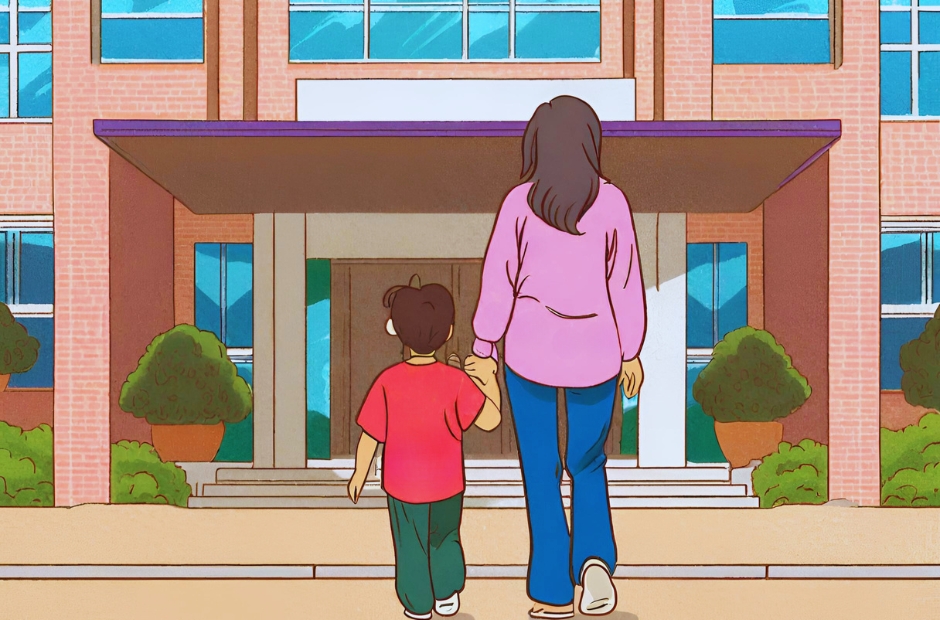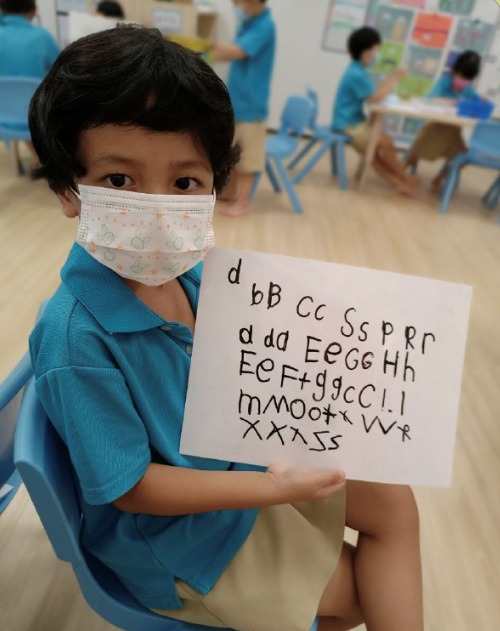Prepping for Primary 1 in the time of Covid
16 Sep 2021
.jpg)
Is your child starting primary school next year? How can parents help to get their child ready, since many orientation activities have been stalled by the pandemic? Teacher and mother of three, Lavinia Denise Selvakumar, shares the many ways she has been prepping her second child for Primary 1 at home, to bridge any gaps and start school with confidence.
It is that time of year again when parents of six-year-olds start to think of the new chapter ahead – primary school.
After long discussions on our preferred schools and taking steps to finally secure a spot in our school of choice, many of us then sit back until late November when primary school orientation happens.
Meanwhile, we trust that our children’s preschool will prepare our child academically and socially for their first step into formal education.
That was me when I eased Aanya, my eldest, into primary school life three years ago. But we now live in a new normal with COVID-19, and I realised that many preschools have had to cut back on the conventional activities that help ease the transition.
They cannot visit a primary school to observe school life or buy food in a school canteen. Parents too, cannot attend school open houses to familiarise themselves and their children with the school grounds and facilities.
In fact, Primary 1 orientations may be entirely virtual and our children will step into their new schools only when term starts in January. This is a big jump for a little six-year-old, isn’t it?
All that time spent together at home also allowed me to build on the skills that Dhilan, my second child of three, has been learning at preschool. It was precisely these preparatory activities and programmes that had helped Aanya be excited and ready for her first day of primary school, so I wanted the same for Dhilan.
Here are some activities we have been practising at home:
Home-prep tip #1: Practise ‘schooling skills’ and being independent
Carrying a schoolbag, packing books and stationery and organising yourself for lessons is big jump for pre-schoolers. Many are used to having items already provided in school or bringing only a bag with a change of clothes (if in childcare).
My son brings only a water bottle to kindergarten daily so it is a big step to make him responsible for so many items. This is what I’ve been doing:
.jpg) Dhilan picked his own P1 backpack (with his favourite shark design) and learns to pack it on his own.
Dhilan picked his own P1 backpack (with his favourite shark design) and learns to pack it on his own.
- Involve him in getting a backpack, wallet, stationery and even shoes.
Dhilan picked out his very own shark backpack and dinosaur-themed pencil case and stationery. He is now in charge of sharpening his pencils every day and puts his stationery away after using them to write or draw.
- Task him with packing a bag even for simple activities.
I get him to pack a bag even if we are visiting his grandmother or going to church. I have a checklist of items including a mask, hand sanitiser, TraceTogether token and a toy to play or book to read at Granny’s. This builds the discipline of packing a bag, unpacking it when we come home, as well as taking ownership for the bag when we are out and not leave it or his belongings lying around. Sometimes, when he is careless, I will hide items he left behind and have him problem-solve on retrieving them, instead of just scolding him for being careless.
- Printing label stickers.
A primary schooler is a busy bee and has many items to bring to school! He must also ensure that the correct items are packed and not lost as they can be easily misplaced. This can be overcome by labelling every single item they own, including uniforms, every single piece of stationery, textbooks, lunchbox, water bottles etc. I printed name label stickers for my son and he now uses them to label all his personal belongings, even his favourite trucks!
- Using a whiteboard as a notebook.
Another important schooling step is the notion of taking notes or writing daily assignments in their notebook. This would definitely be a first for all kindergarteners. I now get him to write his daily to-do list on the whiteboard at home and check against it at the end of the day to see if he has completed his task.
Home-prep tip #2: Manage new routines and transitions
A new school and new school hours usually means a new routine. Especially for pre-schoolers who were in childcare centres for the last few years, it would be difficult for them to understand that primary school life is based in a classroom and has no nap time.
To manage this, I tried to:
- Do a dry run of the transportation route that my son will take to and from school. As my son’s primary school is a 10-minute walk from my house, I made it fun by taking photos of landmarks of key points on our route and creating a map for him to follow and check against as we walked.
.jpg) Aanya and Dhilan work with a wall schedule to better understand the concept of a timetable and time management.
Aanya and Dhilan work with a wall schedule to better understand the concept of a timetable and time management.
- Co-create a timetable at home so my son will be familiar with time-bound activities. Involve your child in doing this so they feel heard and involved in the process and will want to follow it. We created daily timetables for weekday life, weekends and even during holidays! This familiarises children with the concept of a timetable and better manage their time as well as understand that when one activity has to end so they move to another. This will also avoid meltdowns in future.
- Adjust the child’s day to start on a time frame similar to primary school. My son now wakes by 6.30am on weekdays and sleeps by 8pm.
Unfortunately, this means that parents have to adjust their sleep schedules too (the dreaded early morning start). The upside for me was more couple time in the evenings and connecting over Netflix.
.jpg) Dhilan’s jigsaw puzzles help improve his ability to focus on a given task.
Dhilan’s jigsaw puzzles help improve his ability to focus on a given task.
Another challenge is building your child’s attention span and stamina. Lessons in primary school are usually for an hour – unlike in preschool. Kindergarten children do have short attention spans (they wiggle, are chatty, need to move constantly and are used to shorter activities).
We can ease our children into this transition by:
- Setting short tasks for your child to do for 10 minutes in silence (e.g. practise writing simple words or drawing a picture) and extend it to longer periods.
- Curate activities that can build a child’s focus like jigsaw puzzles, Legos or word searches.
Home-prep tip #3: Building financial literacy and canteen skills
.jpg) Learning to recognise different coin types.
Learning to recognise different coin types.
Primary school is when the kids start making their own decisions especially about things like the food they eat and what catches their eye at the school bookshop. This is probably the most challenging transition from preschools, where meals are provided and standardised. The concept of using money is also rather abstract for them. I have been trying to build financial literacy skills in my son by:
- Money sorting and addition activities: I created activity sheets where my son had to sort real coins by denomination, group coins of different denominations together to make $1 or $2 so he understands the practice of adding money. This builds his confidence and familiarity with money.
- Practise using money: Once the child understands currency denominations and simple math, the next step is practising it. We try simple activities at home first: setting up a mini-canteen at home and asking my son to pay for his tea snacks (i.e. a cup of Milo, biscuits). My husband and I often task our son to buy his food at the hawker centre or paying for small grocery purchases like bread. This helps him build confidence in ordering food, counting money on the spot and even putting away change in a wallet. Don’t fret that a simple two-minute order now takes 10 minutes. Most stallholders are very encouraging and even help the child in counting change. We also gave him a savings bank so he saves extra money from his purchases and builds this positive habit from young.
.jpg)
We set up a ‘canteen’ at home to encourage Dhilan to practise ‘paying’ for his snacks.
- Understanding canteen independence: I involve my son in the entire process of buying food at the food centres, carrying the item to the table, putting his mask away neatly, eating on his own, clearing his used crockery/returning trays and putting his mask back on. Needless to say, we have had some accidents (i.e. spilt bowls) but even as he cries for the disappointment or embarrassment, we always hug him and encourage him to keep trying.
Now is the time to grow our children’s sense of independence and build up excitement towards formal schooling.
As my son will be joining his father’s alma mater, we showed him photographs of his Papa in his primary school, his old report card and trophies, making him quite excited to be able to more like his superhero and idol: his Papa!
Amid this excitement and slew of changes, children will often have much to talk about and try to make sense of their insecurities. Do be ready to lend a listening ear and share their excitement or worries over even simple things, like whether they can wear their favourite colour of mask to school!
Let’s equip them with the positivity, confidence and competence they need. Take joy in the little ways we can bond with our little ones and grow our relationship together, even in these extraordinary times.





